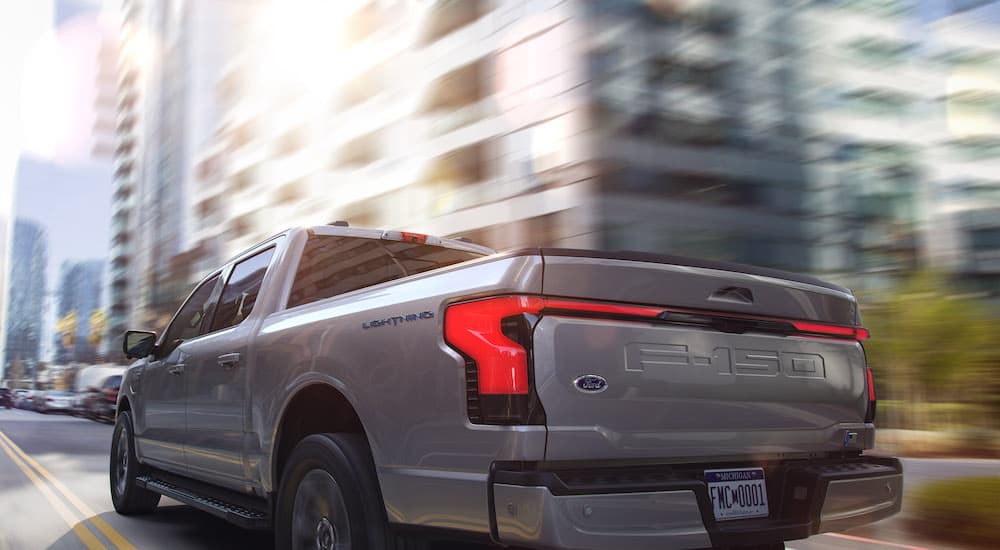With the steady electrification of the modern auto market, many of today’s cars, trucks and SUVs are more efficient — and environmentally friendly — than ever. While this efficiency has been the driving factor in the growth of the EV segment, it’s far from the only advantage of an all-electric powertrain. While the instant acceleration afforded by an EV’s electric motors might be the most thrilling bonus, budget-conscious drivers will be happy to discover that they also offer some substantial benefits when it comes to lifetime ownership and maintenance costs.
While this might be a little confusing for those who think that new technology is always going to come at a premium, it can largely be credited to the fact that EVs are simply a lot less complicated than their gas-powered forebearers. In order to move a vehicle down the road, the typical internal combustion engine (ICE) vehicle relies on more than 2,000 parts working in perfect harmony while EV powertrains can make do with as few as 20 moving parts. This simplicity means fewer parts that can break or require regular maintenance, resulting in a surprisingly low cost of ownership. The typical Ford F-150 Lightning for sale near Folsom will save drivers around 40 percent in scheduled maintenance when compared to a gas-powered model; a stark contrast that can translate into a lot fewer trips to the mechanic and a lot more money in your pocket. That said, EV pickups like the Ford F-150 Lightning are still not exactly maintenance-free. Let’s crack the owner’s manual and take a quick look at the F-150 Lightning’s maintenance schedule, explore Ford’s warranty coverage options and learn how scheduling your next maintenance appointment with a qualified Ford dealership can make such a big difference.
F-150 Lightning Maintenance Schedule
Compared to a gas-powered F-150, the all-electric Lightning is a walk in the park. The ICE version of Ford’s best-selling trucks requires no less than 10 individual maintenance tasks at every scheduled visit while the Lightning often gets by with as few as three to five. Again, this largely comes down to the relatively simple powertrain which lacks a gas engine and all the associated components needed to keep it running. Engine oil and filter replacements, exhaust system inspections, new engine air filters, belt and hose replacement will all be a thing of the past when you upgrade to an EV pickup like the F-150 Lightning. Let’s take a look at some of the most common maintenance tasks for your F-150 Lightning and do a brief overview of the extended schedule.
Tire Replacement: No matter how innovative their powertrains might be, EVs still rely on tires to keep them rolling down the road. In fact, tires are one component where EVs are actually outclassed by their gas-powered cousins. While the typical ICE vehicle can safely use the same tires for 35,000 to 70,000 miles, experts recommend replacing EV tires every 20,000 to 40,000 miles. This mostly comes down to the fact that, thanks to the higher torque provided by their electric motor(s), EV tires tend to wear out a little faster than average.
Tire Rotation: Tire rotation is just as important for an EV as it is for any other vehicle and should be conducted every 5,000 to 10,000 miles.
Wheel Alignment: As we mentioned above, an EV’s tires don’t tend to last as long as those found on an ICE vehicle. That’s why regular tire rotations and wheel alignments are so essential. In order to maximize your tire’s tread life and improve range, try to get a wheel alignment done every 15,000 miles.
Brake Pads and Rotors: While owners still can’t skip out on brake pad and rotor replacement, the regenerative braking feature found in most EVs mean that these parts go through a lot less wear and tear than they would on an ICE vehicle. Drivers can typically expect five years between replacements, which is a notable improvement from ICE vehicles which usually need new pads and rotors every three years.
Fluids: When it comes to fluids, EVs get by with a whole lot less than a gas-powered vehicle. Most EVs just need to have their brake, coolant and transmission fluid changed on a regular basis. The specific schedules can be found in your F-150 Lightning opener’s manual, but generally speaking, they should be checked a couple times a year and replaced every three to five years.
Battery Performance Test: As the most expensive component in an EV, there’s no such thing as being too careful when it comes to your battery. Regular inspections are key as they can alert you to any underlying issues that could cause a battery to lose capacity before its time.
Air Filter Replacement: Vehicle health is important, but so is yours. Replacing the cabin air filter every two or three years will help prevent irritants like dirt, dust and pollen from making their way into the interior.

7,500 to 10,000 miles
- Tire Inspection
- Battery Health Test
- Brake Inspection
20,000 to 30,000 miles
- Coolant Flush
- Fluid Inspection
- Transmission Fluid Check
- Cabin Air Filter Replacement
40,000 to 60,000 miles
- High Voltage Battery Inspection
- Inverter and Electric Motor Inspection
- Air Conditioning System Check
- Tire Rotation
- Battery Performance Test
- Brake Fluid Replacement
70,000 miles and up
- High Voltage Battery Replacement (if needed)
- Transmission Fluid Replacement
- Wheel Alignment Check
- Cabin Air Filter Replacement
Ford Warranty Coverage
Like all new Ford models, the F-150 Lightning comes standard with a generous three-year/36,000-mile Ford factory warranty and an additional five-year/60,000-mile policy that covers all powertrain components. That’s all well and good, but what about the battery? With the absence of the standard gas engine, the battery represents the single most expensive component in the average EV. The truck’s 98.0-kWh standard range battery pack, for instance, will set drivers back $28,000 while the 131-kWh extended range pack can cost as much as $36,000 to replace. That’s no small chunk of change, but Ford’s eight-year/100,000-mile battery warranty goes a long way in alleviating any battery-related anxiety.
Ford’s EV-specific coverage doesn’t end with the eight-year/100,000-mile battery warranty. While the standard warranties are a great starting point, those looking for some supplementary coverage should look into the Ford Protect PremiumCARE EV extended service plan. Available for an average cost of $1,865, this comprehensive 10-year/175,000-mile policy covers most repairs for over 1,000 individual components. From the on-board battery charger and electric motor to the battery energy control module, inverter system controllers and primary electric drive, the Ford Protect PremiumCARE EV extended service plan is designed to keep your EV in tip-top shape. The policy even includes extended coverage for the steering, brakes and front suspension, as well 24/7 roadside assistance should you ever need to change a flat tire, lose your keys or run out of fuel. Ford also offers free towing and up to $1,000 in emergency travel expenses if your F-150 Lightning is out of commission for an extended period.

Why Choose A Dealership?
Regular maintenance is certainly important when it comes to keeping your vehicle on the road, but so is where that maintenance is performed. While some drivers might want to stick with an independent mechanic, there are several reasons to choose a dealership when it comes time to service your Ford F-150 Lightning. The first and most obvious is expertise. When you take your vehicle to a Ford dealership, you know it’ll be serviced by a Ford Senior Master Technician. These technicians have been through more than 500 hours of training — and an additional 250 hours per year — ensuring drivers always enjoy the highest level of care. This institutional knowledge is especially important when it comes to EVs which, thanks to their all-electric powertrains, might be a little too complicated for your average neighborhood mechanic.
A Ford dealership also has all the cutting-edge tools and diagnostic equipment on hand to keep your F-150 running as well as the day it rolled off the lot. Dealerships have access to some of the highest-quality parts on the market, meaning that every repair will be performed with original equipment manufacturer (OEM) or OEM-level parts. These OEM parts are engineered to meet the highest standards and are covered by a 24-month parts and labor limited warranty. As part of an exhaustive, multi-point inspection, Ford technicians will check in on everything from batteries and hoses to fluids, safety systems and suspension components. An independent technician can perform many of these same tasks, but a little Ford-specific knowledge can go a long way when it comes to spotting potential issues before they can balloon into big-ticket repairs.
Drivers aren’t required to visit a dealership for their scheduled maintenance in order to satisfy the conditions of your warranty — it’s actually enshrined in law as part of the Magnuson-Moss Warranty Act — but that doesn’t mean it’s not a good idea. Bringing a Ford vehicle to a Ford dealership confers a number of benefits, especially when it comes to resale value. A vehicle that’s been carefully serviced by qualified technicians is bound to fetch a higher price when it comes time to sell, especially if you’ve held on to all the paperwork. While relying on an independent mechanic might not be a dealbreaker for some buyers, a glovebox stuffed with receipts and work orders from a reputable Ford dealership could be a major bargaining chip when it comes time to negotiate.
The Ford F-150 Lightning represents an exciting step forward for one of the industry’s best-selling nameplates. Ford has managed to combine the hard-working reputation of America’s favorite pickup with an all-new, all-electric powertrain that offers some real benefits when it comes to efficiency and lifetime ownership and maintenance costs. That’s not to suggest that the F-150 Lightning is maintenance-free, but it’s certainly less of an investment in both time and money than any of its gas-powered competitors. Following your F-150 Lightning’s recommended maintenance schedule is one of the easiest ways to ensure its longevity, as is taking it to a Ford dealership for all its maintenance and repair work. With a qualified Ford technician on your side, you can enjoy every driver knowing that your pickup is receiving the highest quality of care. Extended warranty coverage can also provide valuable peace of mind, allowing you to enjoy every ride with the sort of confidence that only such a comprehensive policy can provide.

